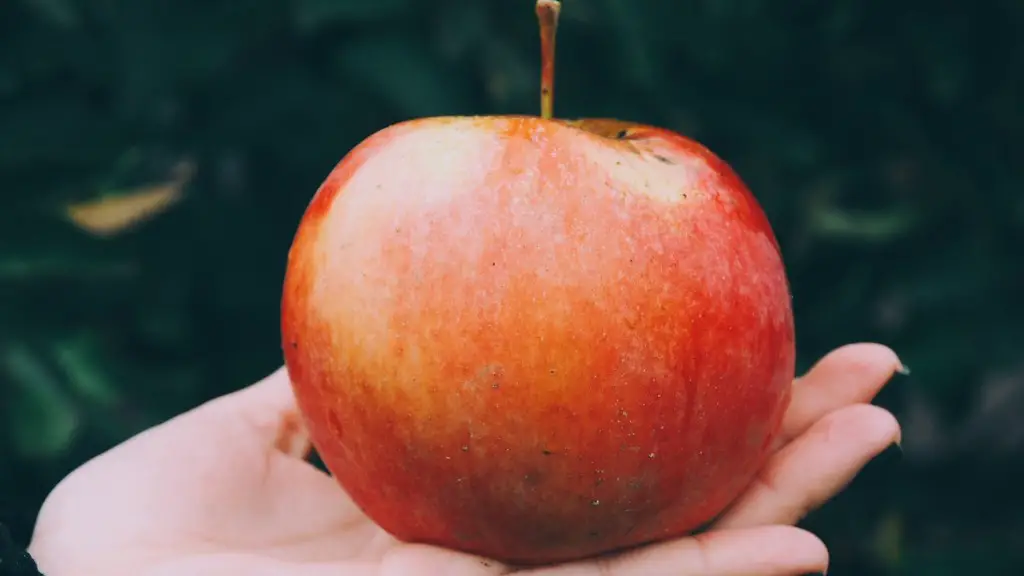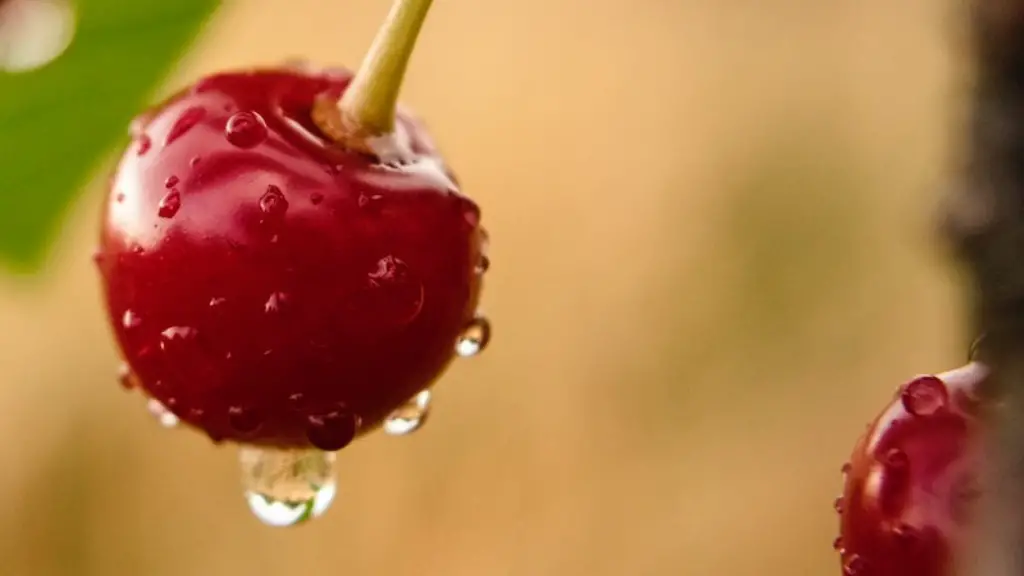Apples from a tree can typically be eaten when they are ripe, usually in autumn or early winter. Apples can be harvested any time after they have developed a full color. The best test for determining when an apple is ripe is to taste it. A fully ripe apple should have both a good flavor and texture. As apples ripen, the skin softens and they become sweeter. When harvesting apples, it’s important to know what sort of apple tree you have. Some apple varieties ripen earlier than others, and some fruits don’t ripen at all when picked. If you are unsure, wait a few days to give them time to ripen, or ask a local expert.
Once the apples are ripe, you can pick them directly off the tree. It’s important to use a gentle touch when picking apples and not to pull or tug on the apples. Using hand pruners or a fruit picker will also help ensure that your apples are not damaged by the picking process. When picking the apples, be sure to include the stem. Apples that have their stems still attached will last longer than those without.
After picking, it is important to immediately store the apples in a cool, dry place. Apples do not like extremely cold temperatures, so be sure to store them in an area that is 45-55°F. If the apples are stored in a bag, make sure to keep the apples separated so they do not touch each other. Also, be sure to inspect the apples before consuming them. Apples that have bruises or spots on them should not be eaten.
Once you have stored your apples in a cool, dry place and inspected them, you can enjoy them in a variety of different ways. Apples can be eaten raw, juiced, cooked, or made into desserts. They are a healthy, refreshing snack and can be enjoyed in many different recipes. Apples can also be preserved in various ways, such as canning or freezing for later use.
Knowing when to pick apples from a tree and how to store and preserve them is important for ensuring an enjoyable experience. Apples can be enjoyed in a variety of different ways and make a healthy, refreshing snack. With proper picking, storage, and preservation, you can enjoy apples year-round.
Apples Varieties
Different apple varieties ripen at different times and can vary in taste, color, and texture. Popular varieties include Red Delicious, Golden Delicious, Gala, Granny Smith, Honeycrisp, and Braeburn. No matter what type of apple tree you have, it’s important to be aware of the different varieties and when the tree usually produces fruit. This will help you to determine when to pick the apples and when to expect a harvest.
For example, Red Delicious apples are usually available from early September to mid-November, while Honeycrisp apples are usually available from August to October. Additionally, Honeycrisp apples have a sweet-tart flavor, while Red Delicious apples have a mild sweetness. Knowing the varietal characteristics of the apples will help you decide when the fruit is at its peak.
The season for apple picking varies depending on location. In the Northeastern United States, apple picking season typically begins in August and extends into November. In the southern United States, apple picking season typically begins in late September and extends into October. It’s important to keep an eye on the weather, as extreme temperatures can delay the start of the season. If you are unsure of your area’s picking season, contact a local expert or visit a nearby orchard.
Depending on the variety and season, apples can be picked directly off the tree. It’s best to wait until the apples are fully ripe before picking. A fully ripe apple should have a good flavor and texture, and the skin should be soft enough to be gently pulled off the tree. Once the apples have been successfully picked, be sure to store them in a cool, dry place for preservation.
Different apple trees can produce fruit at different times of year, so it’s important to be aware of your local apple picking season. Knowing when the apples are ripe is also important for ensuring a good flavor and texture. Proper storage and preservation of the apples is also necessary for a successful harvest.
Harvesting Apples
Harvesting apples is a straightforward process, but there are a few important steps to ensure a successful harvest. When picking apples, care should be taken to ensure the apples are not bruised or damaged. Apples with bruises or spots should not be eaten. When using a hand pruner or a fruit picker, gently twist and remove the apples. Additionally, it is important that the apples are picked with their stems still attached.
The timing of harvests is also important. Apples ripen at different times, so it’s important to be aware of your local apple season and when a particular type of apple is at its peak. Apples are ripe when they have achieved a full color and when they have a good flavor and texture. As apples ripen, the skin softens and they become sweeter. If you are unsure if an apple is ripe, taste it for best results.
Once the apples have been successfully harvested, they should be stored in a cool, dry place for preservation. Apples do not like extremely cold temperatures, so avoid storing them in a refrigerator or freezer. Additionally, when storing in a bag, make sure the apples are separated so they do not touch each other and that they are inspected before consumption. Keeping an eye on the temperature, as well as using gentle picking and immediate storage, are essential to ensuring a successful apple harvest.
Harvesting apples can be a rewarding activity, but it’s important to be aware of the necessary steps for a successful harvest. Knowing when apples are ripe and when to pick them, as well as properly storing and preserving them, are essential for ensuring a great-tasting harvest. With the right knowledge and techniques, you can enjoy apples from your tree all year round.
Apples from a tree can add flavor to any dish and make a healthy, refreshing snack. Knowing what sort of apple tree you have, when the apples are ripe, how to pick them, and how to store and preserve them are essential for a success harvest. With the right knowledge and techniques, you can ensure a successful harvests and enjoy apples year-round.
Preserving Apples
After harvesting and storing apples, they can be preserved in different ways. Apples can be canned, frozen, or dried. Preserving apples is an ideal way to store apples for later use and is especially helpful if you have a large harvest. There are several methods for preserving apples, each with its own advantages.
Canning is a great way to preserve all kinds of fruits and vegetables. Apples can be canned either whole or in slices or chunks. Apples can be canned in a water-bath canner, a pressure canner, or even in an oven. Canning is an inexpensive way to preserve apples and allows for a longer shelf life. Additionally, canning is a great way to use up any bruised or damaged apples as the canning process will get rid of any blemishes.
Freezing apples is another easy way to store them for longer periods of time. Apples can be frozen whole, in slices or chunks, or in a puree. If you decide to freeze apples, it’s important to blanch them first. Blanching will remove any bacteria and help to prevent the apples from browning. Apples can be stored in the freezer for up to one year and can be used in many recipes.
Finally, apples can also be dried as a method of preservation. Drying apples is an ideal way to add sweetness to recipes or to simply enjoy as a snack. When drying apples, it’s important to use low temperatures in order to preserve their flavor and color. Apples can be dried in a dehydrator or in an oven set to low heat. Dried apples can be stored for up to six months.
Preserving apples is an ideal way to store them for later use. Apples can be canned, frozen, or dried and can be used in a variety of recipes. Knowing how to preserve apples is essential for a successful harvest. With proper preservation, you can enjoy apples year-round.
Storing Apples
Knowing how to store apples is key for ensuring a successful harvest. Apples should be stored in a cool, dry place for best results. Apples do not like extremely cold temperatures, so avoid storing them in a refrigerator or freezer. Additionally, if the apples are stored in a bag, make sure to keep them separated so they do not touch each other. This will help to prevent bruising and ensure the apples last longer.
When storing apples, it’s important to inspect them before consuming. Apples that have bruises or spots on them should not be eaten. Additionally, it is important to store apples in a well-ventilated area. Apples can be stored in a basket, perforated bags, or any container that allows air to circulate. This will help to prevent the apples from spoiling.
Storing apples in the refrigerator can also help to prolong their shelf-life. Apples can be stored in the refrigerator for up to one month. However, refrigerating apples can cause them to lose their flavor and texture, so it’s best to store them in a cool, dry place if possible. Additionally, apples stored in the refrigerator should be kept away from other fruits and vegetables and should be inspected before consuming.
Apples can also be stored in the freezer for longer storage periods. Apples should be blanched before freezing, as this will help to prevent the apples from browning and will remove any bacteria. Apples can be stored in the freezer for up to one year. When thawing frozen apples, make sure it is done slowly and gradually in order to preserve their flavor and texture.
Knowing how to store apples is essential for a successful harvest. Avoid storing apples in extremely cold temperatures, as they do not like the cold. Additionally, be sure to inspect the apples before consuming and to keep them separated when storing in a bag. With proper storage, apples will last longer and can be enjoyed year-round.




